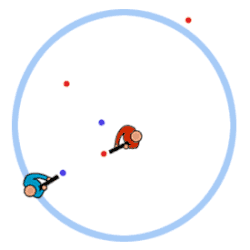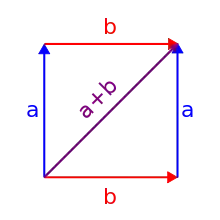Strafing (video games)
Strafing is the act of sliding in a direction, while keeping momentum which carries the player to the intended destination, in order to increase speed. Strafing allows a player to keep the camera focused on a target such as an enemy, while moving in a different direction.
Etymology
Strafing is the military practice of attacking ground targets from low-flying aircraft using aircraft-mounted automatic weapons.[1]
Less commonly, the term is used by extension to describe high-speed firing runs by any land or naval craft such as fast boats, using smaller-caliber weapons and targeting stationary or slowly-moving targets.Techniques
Circle strafing

Circle strafing is the technique of moving around an opponent in a circle while facing them.[5] Circle strafing allows a player to fire continuously at an opponent while evading their attacks. Circle strafing is most useful in close-quarters combat where the apparent motion of the circle strafing player is much greater than that of their stationary enemy, and thus the chance of making the enemy lose track of their target is higher[6] and/or the enemy is required to lead the target when firing. The effectiveness of circle strafing is mitigated when the opponent's weapon fires projectiles that travel instantaneously (also referred to as a hitscan weapon), or fires at a high rate, e.g. with a machine gun.[7]
Circle strafing is especially effective when lag negatively affects the players' ability to hit their target. When latency is high and the game doesn't have client-side hit detection, this can lead to two players circling each other, both missing all their attacks.
Many shooters will allow players to aim down the sights of a gun or use a scope, usually exchanging movement speed and field of vision for greater accuracy. This can make a player more vulnerable to circle strafing, as targets will pass through their field of vision more quickly, they are less capable of keeping up with a target, and their slow movement makes dodging more difficult.
Strafing in melee combat
Circle strafing has also spread to some 3D action and adventure video games that involve melee combat. Circle strafing in melee combat can be made easier with a lock-on system that snaps the camera's (and the player character's) focus on one particular target, guaranteeing that most of the player character's attacks will land a direct hit on the target. It enables the player character to concentrate on moving around the enemy to dodge their attacks while staying automatically focused on the enemy. This can be a crucial strategy against bosses and powerful enemies, and is notably employed in many The Legend of Zelda titles, starting with Ocarina of Time.
Strafe-running

Particularly in early first-person shooters, strafe-running (known as speed-strafing among players of GoldenEye 007 and Perfect Dark, and as trichording among players of the Descent series) is a technique that allows a player to run or fly faster through levels by moving forwards and sideways at the same time. The game combines these actions and the player achieves roughly 1.4 (square root of 2) times the speed they would moving in a single direction. The method used by the game can be demonstrated using vector addition. Pathways into Darkness was one of the first games to allow strafe-running.
The games in which strafe-running can be employed treat forward motion independently of sideways (strafing) motion. If, for each update of the player's location, the game moves the player forward one unit and then moves the player to the side by one unit, the overall distance moved is . Thus, in games with such behavior, moving sideways while simultaneously moving forward will give an overall higher speed than just moving forward, although the player will move in a direction diagonal to the direction being faced. This feature is even more enhanced if moving along three axes (e.g. forward + left + up), providing (roughly 1.73) times greater speed, in games such as Descent.
This technique is not possible in all games; most and especially modern games would clamp the player's speed and acceleration to a uniform maximum when moving in any direction.
Strafe-jumping
Strafe-jumping is a technique used to increase a player's movement speed in computer games based on the Quake engine and its successors, most of which are first-person shooters.
History
Strafe-jumping was a result of a bug in the code base of the 1996 first-person shooter video game Quake. In Quake's sequels it was decided to be kept intact,[8] as it had become a standard technique used by players. The exploit relies on an oversight in acceleration and maximum speed calculation: when pressing a movement key, the game adds an acceleration vector in that direction to the player's current velocity. When the player has reached a maximum speed value, further acceleration is prevented. However, the movement speed limit is only applied in relation to the acceleration vector's direction and not the direction of the overall velocity, meaning that precisely manipulating the angle between overall velocity and this acceleration vector lets the player break the intended speed cap.[9]
Method
Strafe-jumping requires a precise combination of mouse and keyboard inputs. The exact technique involved depends on the game in question. In several games, there are entire maps devoted to this, much like obstacle courses.
The controls are typically as follows:
- The player holds the move forward key, accelerating to the maximum walking speed.
- The player jumps and simultaneously starts holding either the strafe left or the strafe right key.
- While airborne, the player moves the mouse slowly in the direction they're strafing. This turns the character and directs the acceleration to an angle that lets the player break the speed cap.
- To prevent speed loss from ground friction, the player immediately jumps again on landing.
- Strafe-jumping this way will slowly curve the player's trajectory, so to compensate the player can switch the direction of strafing and mouse movement to the opposite side.
Done correctly and continuously, this will gradually increase the player's speed. Mastering this technique requires much practice. Sustained strafe-jumping is mainly a matter of muscle memory, as both the required range and precision of mouse movements increase as the player builds up speed.
In Quake III Arena and some games based on its engine, such as Call of Duty and Wolfenstein: Enemy Territory, slight increases in jump height can be achieved by playing the game at specific frame rates.[10]
Pre Strafe
The pre strafe is an action performed by the player at the start of strafe-jumping, giving an initial burst of speed. It uses the same mechanics as strafe-jumping, but on the ground before the first jump, and requires faster mouse movement.
The controls are as follows:
- The player stands facing 90-135 degrees away from the direction they desire to eventually move in.
- The player starts holding both the move forward key and the strafe key towards the desired direction, and also moves the mouse in the same direction. This turns and rapidly accelerates the player.
- When the player is facing the desired movement direction, they jump to preserve the gained speed.
- The player can now start strafe-jumping and continue accelerating.
Bunny hopping
Bunny hopping is an advanced movement method used in some first-person shooter games which relies on exploiting movement mechanics by combining strafing and jumping. For instance, In games utilising the Quake or GoldSrc game engines or their derivatives, bunny hopping is a technique which leverages strafe-jumping, allowing for a player accelerate beyond the intended maximum movement speed and quickly change direction while in mid-air. Similarly, jumping on sloped surfaces while strafing into them to gain speed can also be called bunny hopping in games such as The Elder Scrolls Online, Portal 2 and a few other first-person-shooter games. Overall, bunny hopping is a technical exploit allowing the player to move faster or more nimbly than normal.
The earliest (and most advanced) method of bunny hopping that utilized strafing controls exists in Quake, the Quake III Arena mod Challenge ProMode Arena, and their derivatives such as Warsow and Xonotic; Half-Life (version 1.1.0.8, released in 2001, introduced a speed cap limiting the effectiveness of bunny hopping[11]) and many of its mods and sibling games such as Team Fortress Classic, Team Fortress 2, Dystopia, and the Counter-Strike series; Painkiller, Dark Messiah of Might and Magic, Kingpin: Life of Crime, Titanfall 2, and Apex Legends.
References
- "Dictionary of Military and Associated Terms 8 November" (PDF). Joint Publication 1-02. U.S. Department of Defense. 2010. Archived from the original (PDF) on 28 February 2017. Retrieved 19 January 2011.
strafing — The delivery of automatic weapons fire by aircraft on ground targets.
- "Oxford Dictionaries – Dictionary, Thesaurus, & Grammar – "Gott strafe England" as origin of "to strafe"". askoxford.com. Archived from the original on March 12, 2007. Retrieved 4 September 2015.
- Richard B.H. Lewis, The Art of Strafing, July 2007, airforce-magazine.com
- "Definition of STRAFE". Merriam-Webster. 2023-10-10. Retrieved 2023-10-12.
- Lancheres, Eric (21 July 2013). Fragging Fundamentals. Fragging Fundamentals. p. 58. ISBN 978-0981210407. Retrieved 2014-11-24.
- Carless, Simon (2004). Gaming Hacks. "O'Reilly Media, Inc.". p. 94. ISBN 0596007140. Retrieved 2014-11-24.
- Brian Schwab (2004). "AI Game Engine Programming". Charles River Media. p. 30. ISBN 1584503440.
- Id Software Inc. "Github Repository - Mentions in Code (No references to ID's opinion in Q2)". Github. Retrieved 4 April 2017.
- "F3quake - Article: Strafing Theory". Archived from the original on 2015-05-08.
- "Call of Duty : A Study on FPS - COD Modding & Mapping Wiki". wiki.zeroy.com. Retrieved 2022-01-10.
- "Changelog before 1110 - Half-Life.Loess.ru". Hl.loess.ru. Retrieved 2019-04-09.